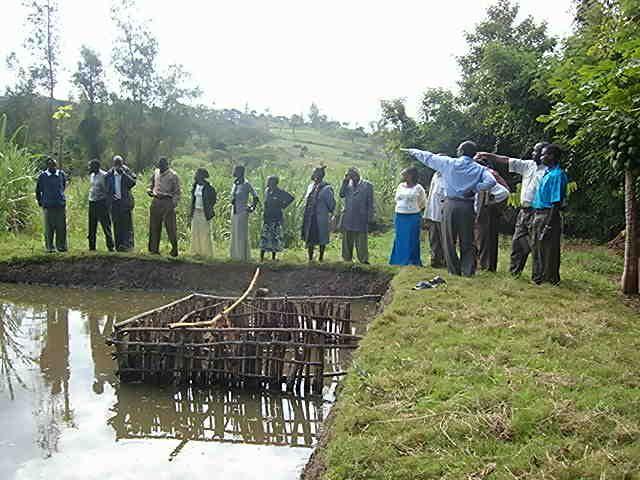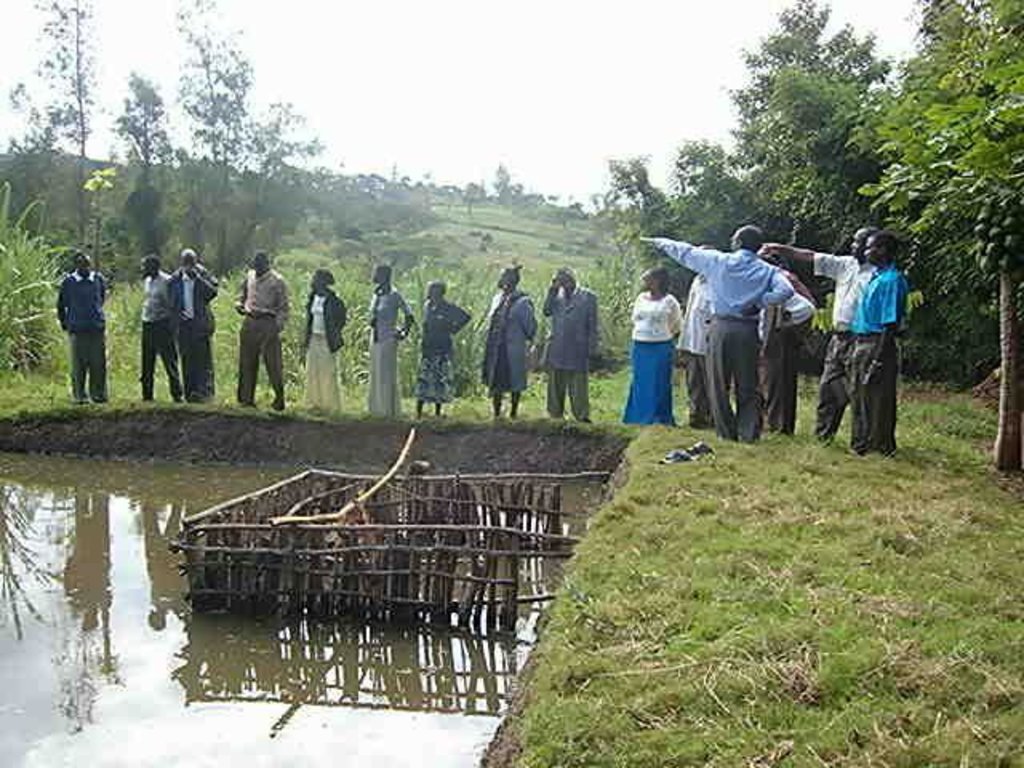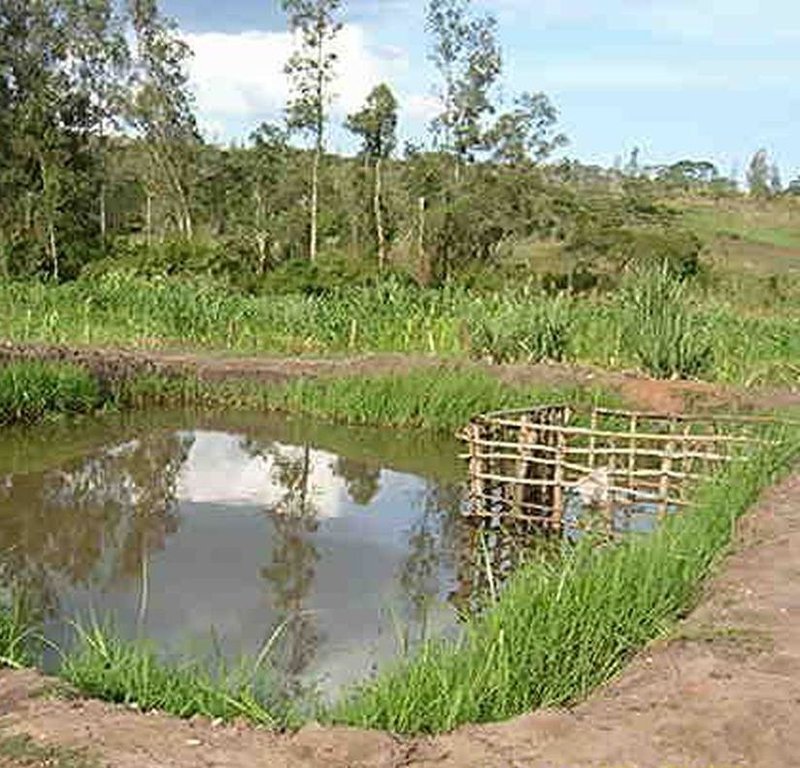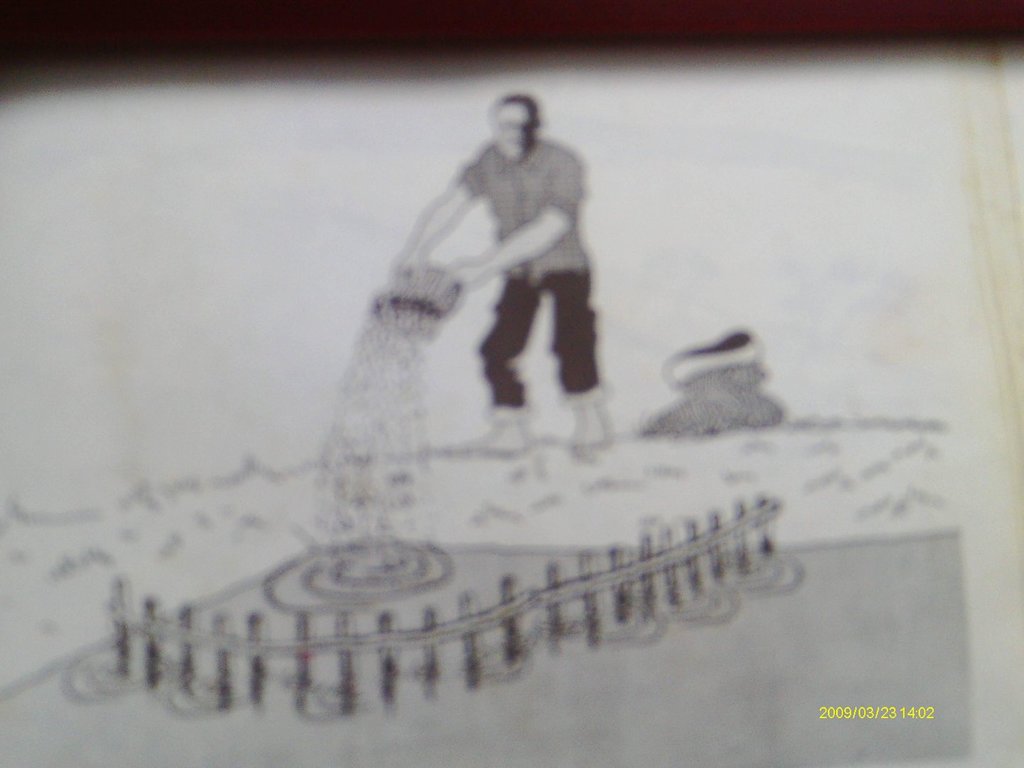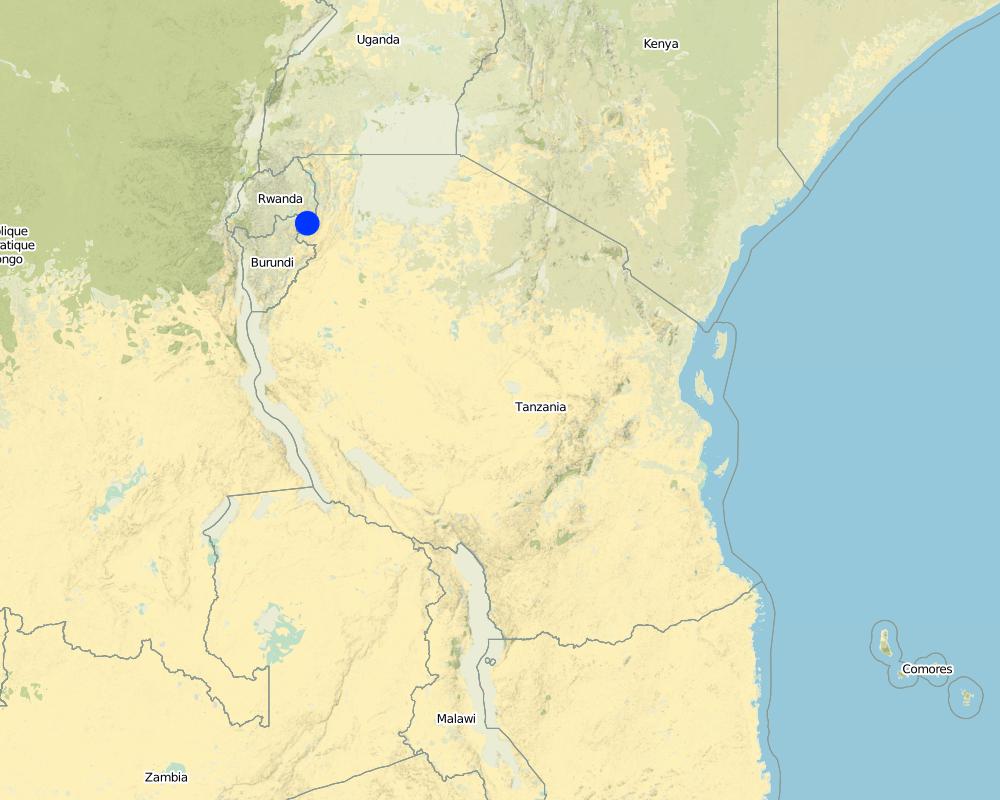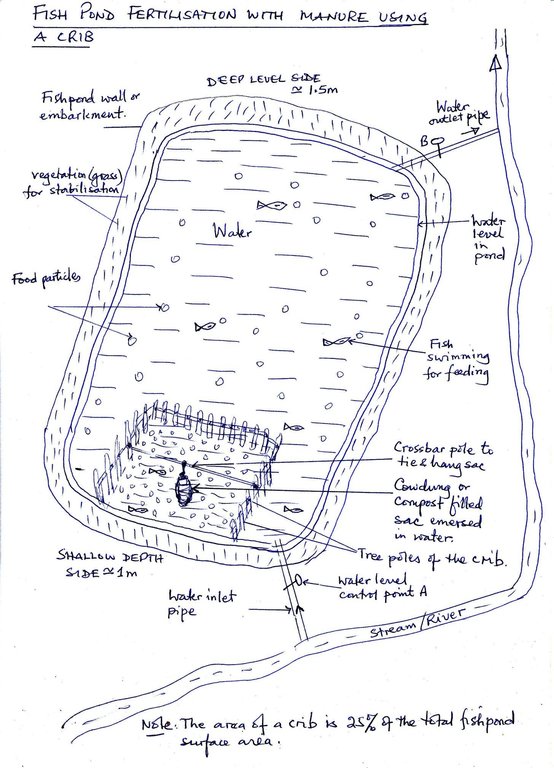FISH POND MANURING USING CRIB METHOD [Tanzania, United Republic of]
- Creation:
- Update:
- Compiler: Philip Ileta
- Editor: –
- Reviewers: David Streiff, Alexandra Gavilano
UFUGAJI WA SAMAKI KWENYE BWAWA
technologies_1154 - Tanzania, United Republic of
View sections
Expand all Collapse all1. General information
1.2 Contact details of resource persons and institutions involved in the assessment and documentation of the Technology
SLM specialist:
Zawadi Waziri
Enviroment Ngara
Tanzania, United Republic of
SLM specialist:
Mugishagwe Wilson
Forestry Ngara
Tanzania, United Republic of
SLM specialist:
Josephat Sangatati
Livestock Ngara
Tanzania, United Republic of
Name of the institution(s) which facilitated the documentation/ evaluation of the Technology (if relevant)
Ngara District Council (Ngara District Council) - Tanzania, United Republic of1.3 Conditions regarding the use of data documented through WOCAT
The compiler and key resource person(s) accept the conditions regarding the use of data documented through WOCAT:
Yes
2. Description of the SLM Technology
2.1 Short description of the Technology
Definition of the Technology:
This is a practice of fish farming whereby farmers excavate ponds ,fill in fresh water,stock-in fish fingerings and manage them to mature or marketable size
2.2 Detailed description of the Technology
Description:
Select a suitable area/site with permanent water source or alongside the flowing river/stream preferably with a clay soil and excavate a suitable sized pond(30mx20m)and a depth of 1,5-2m at the upper and lower side respectively. A crib of 4 m2 for application of manure is constructed using short tree poles at the shallow portion of the pond before filling in water and introducing fish fingerings
Purpose of the Technology: The crib provides an area where Farm yard manure or compost is put to decompose and thereby stimulate the growth of fish foods (phytoplanktons).
Establishment / maintenance activities and inputs: ESTABLISHMENT
-Selection of suitable area and pegging to required size/area
-Excavations to suitable depth
-Dig inlet canal from the water source through the shallow side and outlet canal from the deeper portion of the pond back to the main stream (Alternatively use small metal pipes,bamboo or plastic pipes for inlets and outlets)
-Compact the embankment and stabilize soil by planting suitable grass species such as vetiva spp etc
-Cut 2.5m long strong poles and construct a crib for manure application
-Spread manure at the bottom of the pond and wait for weeds growth (normally 2 weeks)
-Fill in water and stock in fingerings( 1 fingering per sq meter)
-Protect the pond by fencing preferably planting around live fence trees such as Dovyalis caffra,Pthecelobium dulce etc
MAINTANANCE
-Regular cleaning of the pond,and weeding the sorounding environment
-Feeeding with extra foods such as rice/maize brun,rice husks,chopped vegetables,pumpkins and potatoes etc
-Weekly application of farm yard manure or compost(1 tin 15-20 kg) by putting and tying by hanging a sac full in a crib.
-Shaking once daily the hanging sac while in water to release nutrients
Natural / human environment: The pond site should be easily accesible and where possible near homesteads for security purpose
-Harvesting may done by draining the water from the pond, using a seine net,and catch the desired size of fish while returning the young fish to continue growing
In good pond management/feeding farmers are able to harvest every after six months
2.3 Photos of the Technology
2.5 Country/ region/ locations where the Technology has been applied and which are covered by this assessment
Country:
Tanzania, United Republic of
Region/ State/ Province:
Tanzania
Further specification of location:
Ngara District Council
Specify the spread of the Technology:
- evenly spread over an area
If precise area is not known, indicate approximate area covered:
- < 0.1 km2 (10 ha)
Comments:
Total area covered by the SLM Technology is 0.06 ha.
The group owns a fish pond of size 30mx20m in a wetland located in Kasulo village and is stocked with Tilapia spp fingerings
Map
×2.6 Date of implementation
If precise year is not known, indicate approximate date:
- 10-50 years ago
2.7 Introduction of the Technology
Specify how the Technology was introduced:
- through projects/ external interventions
Comments (type of project, etc.):
fish farming in Ngara has been supported since the 1980s by UNICEF,DRDPS and recently by DANIDA through NGOs(REDESO and TCRS)
3. Classification of the SLM Technology
3.1 Main purpose(s) of the Technology
- improve production
- create beneficial economic impact
3.2 Current land use type(s) where the Technology is applied

Waterways, waterbodies, wetlands
- Ponds, dams
Comments:
Major land use problems (compiler’s opinion): -less utilisation of wetlands resources to contribute in improving (livelihood) nutrition and groups/huosehold income
-some fish species (larvifish)may be stocked in ponds to feed on diseases vectors such as mosquitoe larva and reduce malaria incidences
Major land use problems (land users’ perception): To obtain fish for food and surplus harvest for income
Type of cropping system and major crops comments: farmers cultivate small plots of vegetables,sweet potatoes in valleys near fish ponds and chop them to supplement fish meals
3.4 Water supply
Comments:
Number of growing seasons per year:
2
Specify:
Longest growing period in days: 120; Longest growing period from month to month: October to January; Second longest growing period in days: 90; Second longest growing period from month to month: March to May
3.5 SLM group to which the Technology belongs
- beekeeping, aquaculture, poultry, rabbit farming, silkworm farming, etc.
3.6 SLM measures comprising the Technology

agronomic measures
- A6: Residue management
- A7: Others

vegetative measures
- V5: Others

structural measures
- S5: Dams, pans, ponds

management measures
- M5: Control/ change of species composition
Comments:
Secondary measures: management measures
Specification of other agronomic measures: water storage for fish culture
Type of agronomic measures: manure / compost / residues
Type of vegetative measures: scattered / dispersed
3.7 Main types of land degradation addressed by the Technology

biological degradation
- Bh: loss of habitats
Comments:
Secondary types of degradation addressed: Bh: loss of habitats
Main causes of degradation: other human induced causes (specify) (over exploitation of fish in natural water bodies)
Secondary causes of degradation: Heavy / extreme rainfall (intensity/amounts) (Causing siltation,flooding of already constructed fish ponds), other natural causes (avalanches, volcanic eruptions, mud flows, highly susceptible natural resources, extreme topography, etc.) specify (blocking of water channels, ponds due to mud)
3.8 Prevention, reduction, or restoration of land degradation
Specify the goal of the Technology with regard to land degradation:
- prevent land degradation
4. Technical specifications, implementation activities, inputs, and costs
4.1 Technical drawing of the Technology
Technical specifications (related to technical drawing):
Fish pond fertilization with manure using a crib
Location: yyy village. Ngara District Council/Tanzania
Date: 15 May 2012
Technical knowledge required for field staff / advisors: moderate (Once the fishpond is established,the extension kit requires regular monitoring for improvement of fish feeds and outbreak of diseases which are relatively few compared to other livestocks such as pok)
Technical knowledge required for land users: moderate (Following the fish pond manual developed by the district is simple with regard to pond management and feeding regimes)
Main technical functions: increase in nutrient availability (supply, recycling,…)
Secondary technical functions: increase in organic matter, promotion of vegetation species and varieties (quality, eg palatable fodder)
Manure / compost / residues
Material/ species: cowdung
Quantity/ density: 50 kgs
Remarks: applied in crib once weekly per pond
Scattered / dispersed
Vegetative material: G : grass
Number of plants per (ha): 300
Vertical interval between rows / strips / blocks (m): seedlings
Vertical interval within rows / strips / blocks (m): 0.1
Width within rows / strips / blocks (m): 0.1
Grass species: vetiva planted to stablise pond embarkments
Dam/ pan/ pond
Depth of ditches/pits/dams (m): 1.5
Width of ditches/pits/dams (m): 20
Length of ditches/pits/dams (m): 30
Reshaping surface
Length of ditches/pits/dams (m): 2
Construction material (earth): The pond has the deeper side 1.5m and shallower side 1.0m,with the top earth compacted 2m wide
Vegetation is used for stabilisation of structures.
Change of land use practices / intensity level: Wetlands were marginally used only for dry season agriculture and some vegatable growing-now aquaculture intergration adding productive value to it
Control / change of species composition: Most farmers preferered Tilapia nilotica for stocking in fishponds,phytoplanktons growth promoted
Author:
Ileta Philip, c/o DED Ngara District Council
4.2 General information regarding the calculation of inputs and costs
Specify how costs and inputs were calculated:
- per Technology unit
Specify unit:
Fishpond
Specify dimensions of unit (if relevant):
30m x 20m
other/ national currency (specify):
Tanzania shilling
If relevant, indicate exchange rate from USD to local currency (e.g. 1 USD = 79.9 Brazilian Real): 1 USD =:
1600.0
Indicate average wage cost of hired labour per day:
1.25
4.3 Establishment activities
| Activity | Timing (season) | |
|---|---|---|
| 1. | Buying of vetiva | during the rains |
| 2. | Planting of vetiva on embarkments | during rains |
| 3. | Allignment and layout of pond | before rains |
| 4. | Excavation of the pond | before rains |
| 5. | Raising embarkments,compaction construction inlets and outlets | before rains |
| 6. | Collect cow dung | |
| 7. | Purchase fish fingerings | |
| 8. | Purchase tools |
Comments:
Lifespan of dung, fish fingerings and tools: 3 years
4.4 Costs and inputs needed for establishment
| Specify input | Unit | Quantity | Costs per Unit | Total costs per input | % of costs borne by land users | |
|---|---|---|---|---|---|---|
| Labour | Planting of vetiva on embarkments | persons/day | 2.0 | 1.25 | 2.5 | 100.0 |
| Labour | Allignment and layout of pond | persons/day | 2.0 | 1.25 | 2.5 | 50.0 |
| Labour | Excavation of the pond | persons/day | 120.0 | 1.88 | 225.6 | 100.0 |
| Labour | Raising embarkments,compaction construction inlets and outlets | persons/day | 3.0 | 1.25 | 3.75 | 100.0 |
| Equipment | Fish fingerings | pieces | 1000.0 | 0.06 | 60.0 | 20.0 |
| Equipment | Tools | pieces | 4.0 | 12.5 | 50.0 | 20.0 |
| Equipment | Vetiva | pieces | 300.0 | 0.16666 | 50.0 | 100.0 |
| Fertilizers and biocides | Cowdung | kg | 50.0 | 1.25 | 62.5 | 100.0 |
| Total costs for establishment of the Technology | 456.85 | |||||
| Total costs for establishment of the Technology in USD | 0.29 | |||||
Comments:
Duration of establishment phase: 4 month(s)
4.5 Maintenance/ recurrent activities
| Activity | Timing/ frequency | |
|---|---|---|
| 1. | Application of cowdung | weekly |
| 2. | Application of extra feeds | fortnight |
| 3. | Clean weeding | monthly |
| 4. | Trimming the live fence,weeding and monitoring | dry seson |
| 5. | Repairing of walls | after heavy storms |
| 6. | Management of fingerings -monitoring of growth,control of overpopulation | monthly |
| 7. | Cowdung application and manipulation for nutrients release | weekly |
4.6 Costs and inputs needed for maintenance/ recurrent activities (per year)
| Specify input | Unit | Quantity | Costs per Unit | Total costs per input | % of costs borne by land users | |
|---|---|---|---|---|---|---|
| Labour | Clean weeding | persons/day | 2.0 | 1.25 | 2.5 | 100.0 |
| Labour | Trimming the live fence,weeding and monitoring | persons/day | 2.0 | 1.25 | 2.5 | 100.0 |
| Labour | Repairing of walls | persons/day | 2.0 | 1.25 | 2.5 | 100.0 |
| Labour | Management of fingerings | persons/day | 4.0 | 1.6 | 6.4 | 100.0 |
| Equipment | Extra feeds (maize and ricebran) | kg | 10.0 | 1.88 | 18.8 | 100.0 |
| Fertilizers and biocides | Cowdung | kg | 50.0 | 1.25 | 62.5 | 100.0 |
| Other | Labour: Cowdung application and manipulation for nutrients release | persons/day | 1.0 | 1.25 | 1.25 | 100.0 |
| Total costs for maintenance of the Technology | 96.45 | |||||
| Total costs for maintenance of the Technology in USD | 0.06 | |||||
Comments:
the costs are calculated per fish pond of size 20m width,30m length and depth 1.5m
4.7 Most important factors affecting the costs
Describe the most determinate factors affecting the costs:
labour especially during excavations(establishment phase)
cowdung when the land user buys instead of obtaining from the homestead/kraal
5. Natural and human environment
5.1 Climate
Annual rainfall
- < 250 mm
- 251-500 mm
- 501-750 mm
- 751-1,000 mm
- 1,001-1,500 mm
- 1,501-2,000 mm
- 2,001-3,000 mm
- 3,001-4,000 mm
- > 4,000 mm
Specify average annual rainfall (if known), in mm:
950.00
Specifications/ comments on rainfall:
Length of dry periods 4 months
Main rain season Oct to Dec/January, Second season March to Mid May
Agro-climatic zone
- sub-humid
Thermal climate class: tropics. Hot during the days slighly cold nights,avarage temp range18-30C
5.2 Topography
Slopes on average:
- flat (0-2%)
- gentle (3-5%)
- moderate (6-10%)
- rolling (11-15%)
- hilly (16-30%)
- steep (31-60%)
- very steep (>60%)
Landforms:
- plateau/plains
- ridges
- mountain slopes
- hill slopes
- footslopes
- valley floors
Altitudinal zone:
- 0-100 m a.s.l.
- 101-500 m a.s.l.
- 501-1,000 m a.s.l.
- 1,001-1,500 m a.s.l.
- 1,501-2,000 m a.s.l.
- 2,001-2,500 m a.s.l.
- 2,501-3,000 m a.s.l.
- 3,001-4,000 m a.s.l.
- > 4,000 m a.s.l.
Indicate if the Technology is specifically applied in:
- concave situations
5.3 Soils
Soil depth on average:
- very shallow (0-20 cm)
- shallow (21-50 cm)
- moderately deep (51-80 cm)
- deep (81-120 cm)
- very deep (> 120 cm)
Soil texture (topsoil):
- medium (loamy, silty)
- fine/ heavy (clay)
Topsoil organic matter:
- high (>3%)
- medium (1-3%)
If available, attach full soil description or specify the available information, e.g. soil type, soil PH/ acidity, Cation Exchange Capacity, nitrogen, salinity etc.
Soil depth on average: Shallow (ranked 1, loamy to heavy clayey basement) and moderately deep (ranked 2)
Soil fertility: Medium (ranked 1), low (ranked 2) and high (ranked 3)
Topsoil organic matter is medium (ranked 1) and high (ranked 2)
Soil drainage / infiltration is poor and retains water in pond permanently, but medium in severe dry spell and water level decrease to half pond depth.
Soil water storage capacity is high near wetlands and permanent streams. Sometimes also very high
5.4 Water availability and quality
Ground water table:
on surface
Availability of surface water:
good
Water quality (untreated):
for agricultural use only (irrigation)
Comments and further specifications on water quality and quantity:
Availability of surface water: Good (ranked 1) and excess (ranked 2, the site of the pond is located such that at maximum flooding it shoul d not be reached by flood water to prevent fish escape/overflow)
Water quality (untreated): For agricultural use only: Wetlands used for dry season farming and small horticultural gardens. Farmers fetch water in the streams due to unavailability of safe water points
5.5 Biodiversity
Species diversity:
- low
Comments and further specifications on biodiversity:
Decreasing rapidly due to pollution of water sources, deforeatstion and overexploiation of natural fish stocks
5.6 Characteristics of land users applying the Technology
Market orientation of production system:
- subsistence (self-supply)
- mixed (subsistence/ commercial)
Off-farm income:
- > 50% of all income
Relative level of wealth:
- poor
- average
Individuals or groups:
- groups/ community
Level of mechanization:
- manual work
Gender:
- women
- men
Indicate other relevant characteristics of the land users:
Difference in the involvement of women and men: Excavations usually by men labour but for maintanance activitiies women play increasing roles
Population density: 10-50 persons/km2
60% of the land users are average wealthy.
20% of the land users are poor.
Off-farm income specification: Most of the farmers with ponds have livestock and apply cow dung instaed of compost
Market orientation of production system: Mixed (farmers sell some surplus fish although productivity still below avarage)
5.7 Average area of land used by land users applying the Technology
- < 0.5 ha
- 0.5-1 ha
- 1-2 ha
- 2-5 ha
- 5-15 ha
- 15-50 ha
- 50-100 ha
- 100-500 ha
- 500-1,000 ha
- 1,000-10,000 ha
- > 10,000 ha
Is this considered small-, medium- or large-scale (referring to local context)?
- small-scale
5.8 Land ownership, land use rights, and water use rights
Land ownership:
- communal/ village
- group
Land use rights:
- communal (organized)
Water use rights:
- open access (unorganized)
Comments:
water use is free for use by all community members especially for agricultural activities
5.9 Access to services and infrastructure
health:
- poor
- moderate
- good
education:
- poor
- moderate
- good
technical assistance:
- poor
- moderate
- good
employment (e.g. off-farm):
- poor
- moderate
- good
markets:
- poor
- moderate
- good
energy:
- poor
- moderate
- good
roads and transport:
- poor
- moderate
- good
drinking water and sanitation:
- poor
- moderate
- good
financial services:
- poor
- moderate
- good
6. Impacts and concluding statements
6.1 On-site impacts the Technology has shown
Socio-economic impacts
Production
fodder production
Comments/ specify:
Phytoplanktons feeds
production area
Quantity before SLM:
0
Quantity after SLM:
0.06
Comments/ specify:
This is the surface area of the pond
Income and costs
farm income
Quantity before SLM:
100
Quantity after SLM:
375
Comments/ specify:
Market for fish is available when good size
Socio-cultural impacts
food security/ self-sufficiency
Comments/ specify:
From increased income
health situation
Comments/ specify:
Animal protein source menu, but malaria and bilhazia vectors when ponds are not well kept/managed
livelihood and human well-being
Comments/ specify:
When the suitable species of fish is stocked and proper fish pond management procedures adhered to -the harvest are high-at least once to twice per year-but this requires high initial and maintanance capital -routine extension from aquaculture experts is highly needed to enable farmers realise profits
Ecological impacts
Soil
soil organic matter/ below ground C
Comments/ specify:
From decomposition of cow dung
Biodiversity: vegetation, animals
plant diversity
Comments/ specify:
Phytoplanktons and water weeds
habitat diversity
Comments/ specify:
Other water fauna and flora which are not predators may be allowed to flourish
6.2 Off-site impacts the Technology has shown
downstream flooding
Comments/ specify:
Water retained in ponds when adopted farmers increase
6.3 Exposure and sensitivity of the Technology to gradual climate change and climate-related extremes/ disasters (as perceived by land users)
Gradual climate change
Gradual climate change
| Season | increase or decrease | How does the Technology cope with it? | |
|---|---|---|---|
| annual temperature | increase | not well |
Climate-related extremes (disasters)
Climatological disasters
| How does the Technology cope with it? | |
|---|---|
| drought | not well |
Hydrological disasters
| How does the Technology cope with it? | |
|---|---|
| general (river) flood | not well |
Comments:
The productivity of the fish pond is determined by many factors including the selected species of fish,the feeding levels and the temperature of water. Most tropical fish species grows well when the temperature of the pond water remains warm
6.4 Cost-benefit analysis
How do the benefits compare with the establishment costs (from land users’ perspective)?
Short-term returns:
positive
Long-term returns:
positive
How do the benefits compare with the maintenance/ recurrent costs (from land users' perspective)?
Short-term returns:
positive
Long-term returns:
positive
Comments:
Initial establishment capital high
Cow dung may be obtained free from kraal or altenative use compost
manure
6.5 Adoption of the Technology
- single cases/ experimental
If available, quantify (no. of households and/ or area covered):
3 households
Of all those who have adopted the Technology, how many did so spontaneously, i.e. without receiving any material incentives/ payments?
- 0-10%
Comments:
3 land user families have adopted the Technology with external material support
Comments on acceptance with external material support: The fish ponds project attracted many families to engage in the activities,the constraints were high capital investments and poor pond managent
There is a little trend towards spontaneous adoption of the Technology
Comments on adoption trend: especially for well off farmers with land holdings near wetlands and streams
6.7 Strengths/ advantages/ opportunities of the Technology
| Strengths/ advantages/ opportunities in the land user’s view |
|---|
|
Availability of permanent water sources especially streams How can they be sustained / enhanced? Conservation bylaws enforced on bufferzones |
| Strengths/ advantages/ opportunities in the compiler’s or other key resource person’s view |
|---|
|
Availability of permanent water sources especially streams How can they be sustained / enhanced? Conservation bylaws enforced on bufferzones |
|
Farmers owns cattle/shorts How can they be sustained / enhanced? Enhance crop and livestock intergration |
|
Wetlands are owned comunally and by village governments How can they be sustained / enhanced? Bylaws enforcement to prevent encroachment and pollution |
6.8 Weaknesses/ disadvantages/ risks of the Technology and ways of overcoming them
| Weaknesses/ disadvantages/ risks in the land user’s view | How can they be overcome? |
|---|---|
| High capital investments | Family oriented groups have some success ,to think of some subsidies throgh government or simple credit schemes |
| Weaknesses/ disadvantages/ risks in the compiler’s or other key resource person’s view | How can they be overcome? |
|---|---|
| High capital investments | Group approach used -although many groups fail to sustain the ponds |
Links and modules
Expand all Collapse allLinks
No links
Modules
No modules


